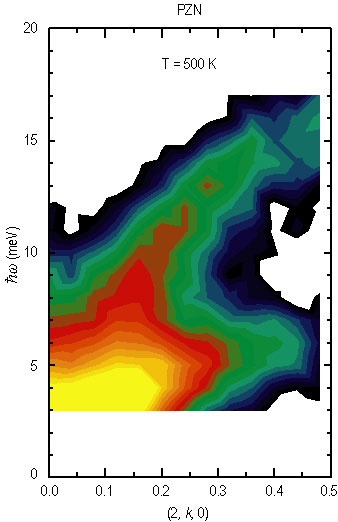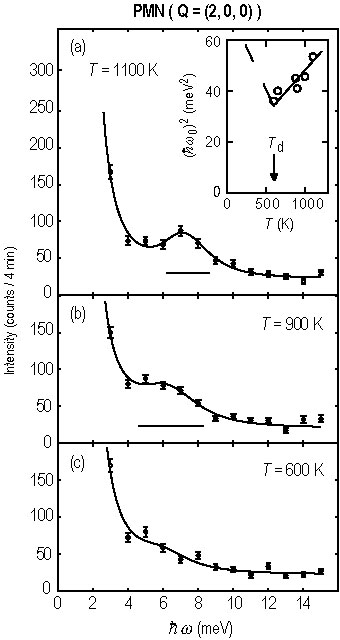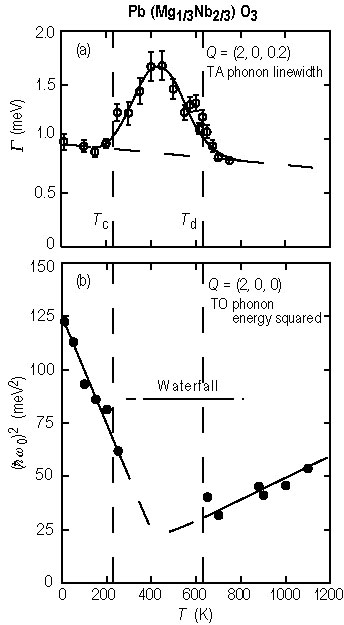Relaxor ferroelectrics exhibit exceptional piezoelectric properties. Single crystals of some of these materials can achieve ultrahigh strains under applied electric fields that are fully one order of magnitude larger than those attainable in conventional lead-zirconate-titanate (P Z T) ceramics, which are widely used in solid-state actuators that convert electrical energy into mechanical energy. The additional properties of large electromechanical coupling and low dielectric loss suggest that industrial use of relaxors may revolutionize the areas of medical imaging, naval sonar, and other acoustic applications. Relaxors are further characterized by a markedly frequency-dependent dielectric susceptibility that is very broad in temperature. The recent neutron scattering studies briefly described here provide new insight on the behavior of these systems.
A key feature that appears to be common to all of the relaxor compounds, and which is believed to play a funda-mental role in producing the enhanced piezoelectricity, is the formation at high temperature of tiny regions of local and randomly-oriented electric polarization just several unit cells in size, also known as polar nanoregions (P N R). The existence of these P N R was inferred from the observation that the optical index of refraction in a variety of disordered ferroelectric systems deviates from a linear temperature dependence at a temperature T sub d far above T sub c (Refer to reference 2).
Lead zinc sub 1/3, niobium sub 2/3, oxygen sub 3, (P Z N), and lead magnesium sub 1/3, niobium sub 2/3, oxygen sub 3 (PMN) are two of the most studied compounds as their piezoelectric responses rank among the highest (Refer to reference 1). These compounds crystallize in the complex perovskite structure lead B prime, B double prime oxygen sub 3, where the B prime and B double prime atoms are generally heterovalent. Thus the relaxor compounds possess not only chemical disorder, but usually a mixed-valence character as well.
Our studies of P Z N and P M N have focused on understanding the mechanism underlying the formation of the P N R, as well as their effect on the lattice dynamics. The latter are clearly manifest in neutron scattering measurements. The long-wavelength transverse optic (T O) phonons are heavily damped in energy below T sub d in P Z N, which gives rise to the anomalous “waterfall” feature shown in Figure 1 (Refer to reference 3). This damping is strongly wave vector dependent, and becomes significant when the wavelength of the lattice vibration becomes comparable to the average size of the P N R, which is estimated to be of the order of 30 angstroms to 40 angstroms.

| Figure 1. Contour plot of the neutron inelastic scattering intensity measured in P Z N in its cubic phase in the (2 0 0) Brillouin zone. The color scale varies logarithmically with intensity, and is limited in range to make the weaker features more visible. |
Subsequent experiments were performed above T sub d = 620 K in P M N to look for a soft mode, given the obvious similarities to the classic soft-mode ferroelectric lead-titanium-oxygen sub 3. Surprisingly, the phonon damping persists well above T sub d, as shown in Figure 2 (Refer to reference 4). This implies that the P N R exist as dynamic entities above T sub d, but are still effective at inhibiting the propagation of long wavelength phonon modes. Even more interesting is how the zone-center T O mode softens and broadens in energy as the temperature approaches T sub d from above, and that only the zone-center T O mode becomes overdamped (no peak at non-zero energy) at T sub d.. Modes at higher wave vector q become overdamped too, but only below T sub d.. This behavior suggests that the zone-center T O mode condenses at T sub d, thereby giving rise to the P N R.. Consistent with this picture is the observation that the square of the zone-center T O mode energy varies linearly with temperature, as happens in normal soft-mode ferroelectrics. This is shown in Figure 3, which summarizes the soft T O mode dynamics in P M N between 10 K and 1100 K (Refer to reference 5).

| Figure 2. Temperature dependence of the zone-center T O phonon in P M N measured at (2 0 0). |

| Figure 3. Summary of the T A and soft mode dynamics in P M N between 10 K and 1100 K. |
An anomalous broadening of the acoustic modes, shown in the upper panel of Figure 3, also occurs at T sub d, as does the onset of diffuse scattering associated with the P N R. The diffuse scattering structure factors can be reconciled with those of the T O phonons in different Brillouin zones by postulating a uniform shift of the P N R along their polarization direction (Refer to reference 6). Furthermore, a model that couples the T A and T O modes is able to describe all of the observed phonon line shapes extremely well (Refer to reference 7). This then suggests a novel idea in which P M N exhibits the condensation of a coupled soft T O mode at T sub d. Such a coupled-mode would carry an acoustic component, and thus provide a natural explanation of the uniform shift of the P N R. If true, this would complete an elegant description for the dynamical formation of the P N R in P M N, and most likely other relaxors as well.
References
1] S.-E. Park and T. R. Shrout, J. Appl. Phys. 82, 1804 (1997).
[2] G. Burns and F. H. Dacol, Solid State Comm. 48, 853 (1983).
[3] P. M. Gehring, S.-E. Park, and G. Shirane, Phys. Rev. B63, 224109 (2000).
[4] P. M. Gehring, S. Wakimoto, Z.-G. Ye, and G. Shirane, Phys. Rev. Lett. 87, 277601 (2001).
[5] S. Wakimoto, C. Stock, R. J. Birgeneau, Z.-G. Ye, W. Chen, W. J. L. Buyers, P. M. Gehring, and G. Shirane, Phys. Rev. B65, 172105 (2002).
[6] K. Hirota, Z.-G. Ye, S. Wakimoto, P. M. Gehring, and G. Shirane, Phys. Rev. B65, 104105 (2002).
[7] S. Wakimoto, C. Stock, Z.-G. Ye, W. Chen, P. M. Gehring, and G. Shirane, submitted to Phys. Rev. B.
Authors
P. M. Gehring
NIST Center for Neutron Research
National Institute of Standards and Technology
Gaithersburg, MD 20899-8562
S. Wakimoto and C. Stock
University of Toronto
Toronto, Ontario
Canada M5S 1A7
Z.-G. Ye and W. Chen
Simon Fraser University
Burnaby, British Columbia
Canada V5A 1S6
G. Shirane
Brookhaven National Laboratory
Upton, NY 11973
Back to FY2002 HTML main page
Go to next article
To view all symbols correctly, please download Internet Explorer 6 or Netscape 7.1